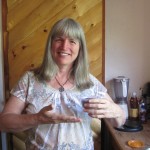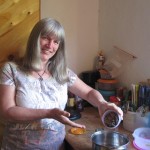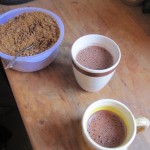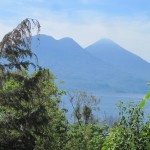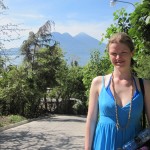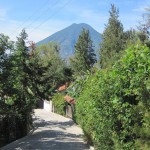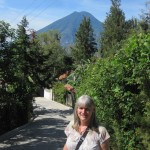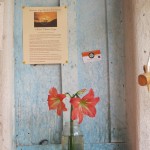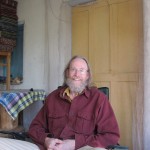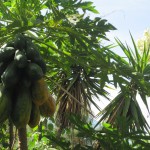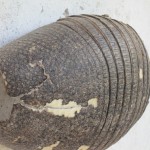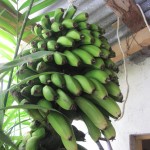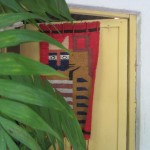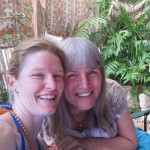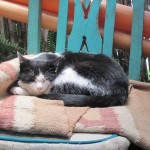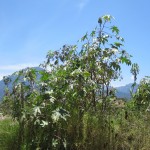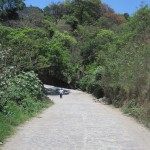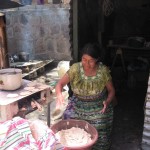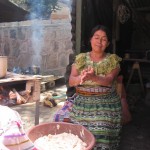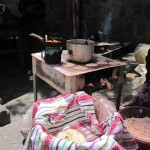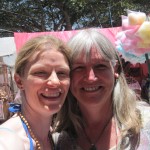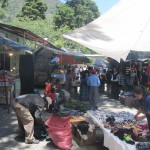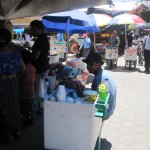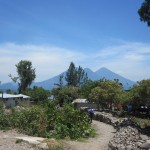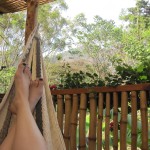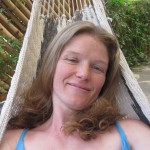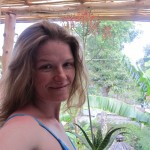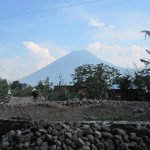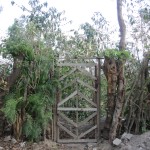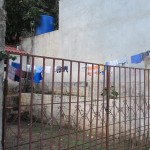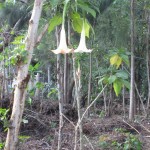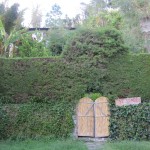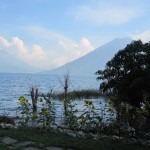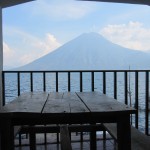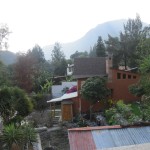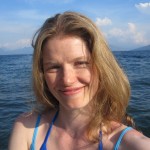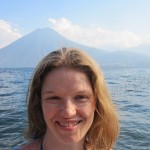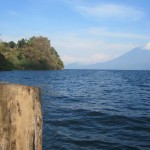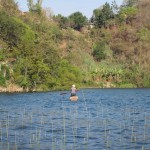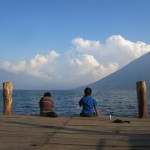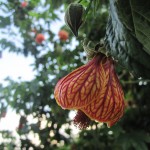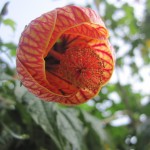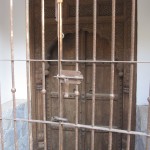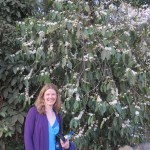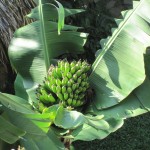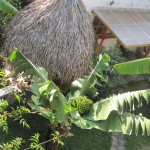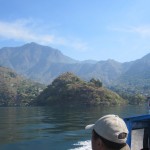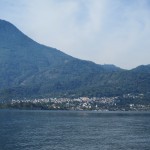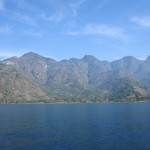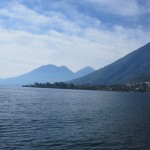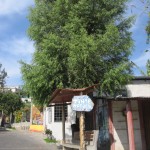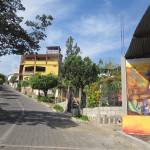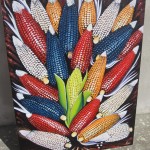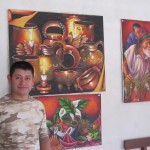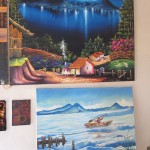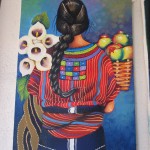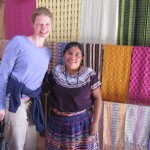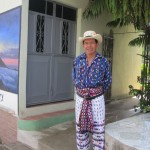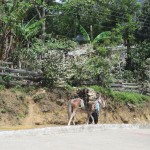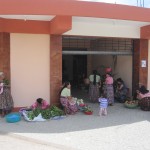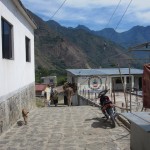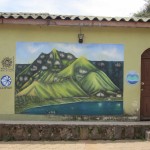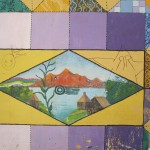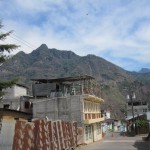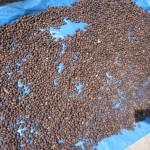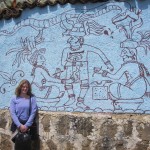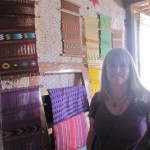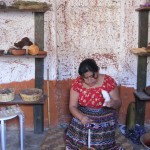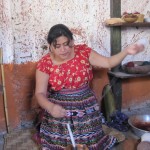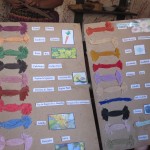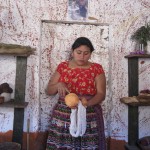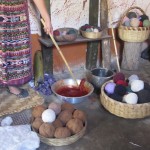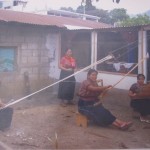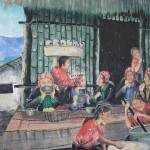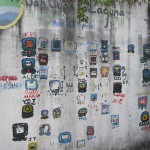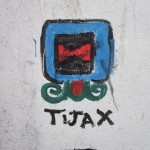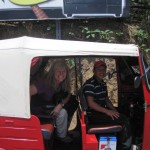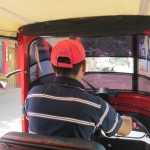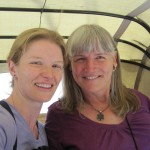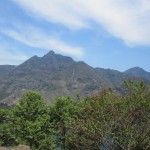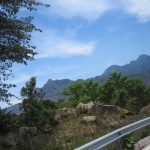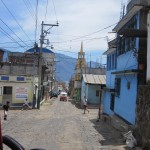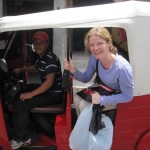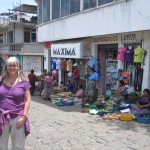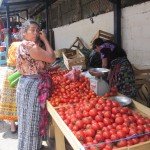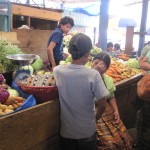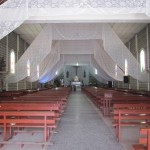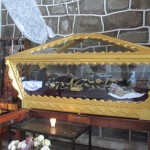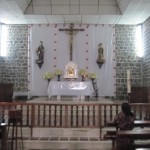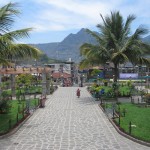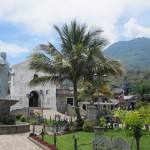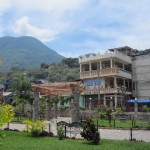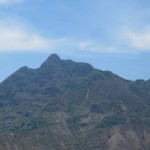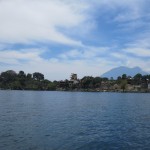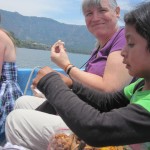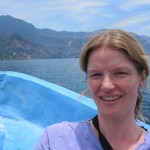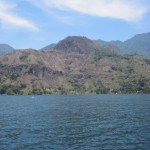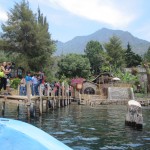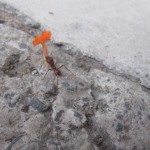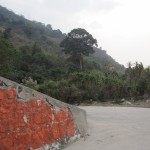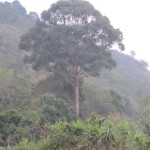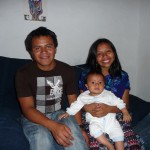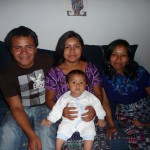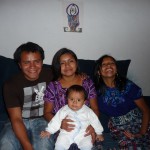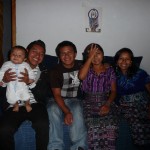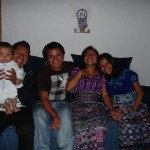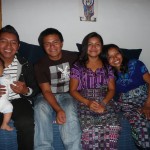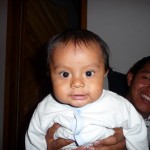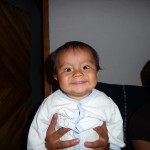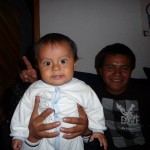This is part two of a collection of photos taken during the final week of April when my friend Pyper came to visit. These photos cover Tuesday, April 25 and Wednesday, April 26, 2012. Included are photos from Keith’s porch, and various areas of San Marcos, San Juan, and San Pedro.
As usual, the photos in this post are thumbnail images. Please click on any photo to enlarge it. The thumbnails leave much to be desired as far as colors and resolution — plus the thumbnails clip all of the edges. I use thumbnails for the post itself, because it gives people the opportunity to get a summary glimpse without downloading huge amounts of data for the high-res photos.
CLICK ON ANY PHOTO TO ENLARGE.
Chocolate Or Bust
Early Tuesday morning, Pyper and I have a private chocolate ceremony with Keith. Since our time is short, we decide to drink chocolate before walking out to Keith’s home.
In the little plastic container in my hand, I hold three ounces of chocolate. Keith buys whole cacao seeds/beans, being careful to choose those with the highest quality for our needs. Then, the beans are lightly roasted and hand peeled by the women from five different local Mayan families here in San Marcos. When we need more chocolate, those peeled beans are then taken to a mill in San Pedro, where they are ground. The mild heat from the grinding process heats the beans just enough to melt the cacao butter. The semi-liquid chocolate is brought back to San Marcos in five-gallon buckets, where a group of us spoon the chocolate into plastic bags. Once they are weighed and sealed, the bags quickly harden. When I need to use the chocolate, I chop up a one pound block into small pieces.
What I hold in my hand is three ounces of those small chopped pieces.
In this photo you can see into the plastic container much better. I have heated two cups of water to a temperature of about 120 degrees farenheit, just hot enough that I cannot keep my finger in the water. It does not need to be boiled. I am pouring the chocolate into the hot water.
A typical ceremonial serving is 1.5 ounces per person. Normally, you do not want to drink more than 2 ouinces, because chocolate is a natural bitter substance, and as those familiar with bitter substances know, if you consume too much, it can make you quite nauseas.
The finished product (in the mugs). With the chocolate melted in hot water, we then add spices. The contents of that blue plastic container are what we call “Panela” here in Guatemala. This “raw cane sugar” has different names in various other parts of Latin America. The sweeteners and spices are optional, but today I add panela, vanilla, cinamon, and a little cayenne pepper.
Off To The Ceremony
A beautiful view of the Atitlan and Toliman volcanoes, as seen from the top of the steep road leading down to Keith’s house.
Pyper standing at the top of that road, the same volcanoes in the background.
Looking down the steep road. At the bottom, you end up at the lake.
Me, posing at the same spot, but from a different angle. The San Pedro volcano towers above me.
Some beautiful flowers in Keith’s window.
Keith, sitting in front of his kitchen door as we prepare to begin the ceremony.
A papaya tree, filled with papayas. This tree is just a few feet from Keith’s porch, in the garden on the way down the steps.
An old armadillo shell hanging on the wall of Keith’s bodega (storage shed). I have never seen one here, but I am told that there are indeed armadillos in this area.
A clump of bananas hanging on one end of the porch. Keith has many banana trees on his property, and almost always has a large supply of ripening bananas. They are cut from the tree while they are still green. Otherwise, the birds would get into them and make a mess of them.
A cute little Mayan rug hanging on Keith’s bathroom door, at the far end of the porch.
Pyper and I, preparing for the ceremony.
And of course, we cannot forget Squeaky … Keith’s healer cat. I have seen Squeaky do some amazing things.
She adopted Keith a few years back when she showed up on Keith’s porch and asked if she could live there. Being as friendly as she is, she was probably raised by westerners who then abandoned her when they left. Keith resisted calling her Squeaky, but he finally chose that name because she literally “squeaks” at everything … especially when it is dinner time.
Time For Tortillas
After our private morning session with Keith, there is a special Tuesday-afternoon public ceremony. Since we do not have time to eat before the ceremony, Pyper and I quickly run into town to purchase some tortillas.
A view of the volcanoes while walking back in to town.
If you stand on the top of the steep road in previous photos, this is the road that leads from there, heading west in a generally winding way, back to the center of San Marcos.
This Mayan woman is making tortillas in the center of town. To her right is a wood stove with the fire going inside. It has a metal griddle for a top. In the large plastic container in front of her is a lot of freshly ground maize (corn). There is a complicated process involved to soak the corn before it is ground.
In this photo, she is molding a new tortilla in her hands. The tortillas they make here are about four or five inches in diameter, and perhaps an eighth of an inch thick.
In the background are tortillas (and other things) cooking on the wood stove. In the foreground are freshly cooked tortillas in the basket lined by a colorful cloth.
Pyper and I waiting for the tortillas. There are lots of booths lining the street this week because this is the annual week of “Feria” for San Marcos … the birthday celebration for the town’s patron saint, Saint Mark.
A small sampling of the vendor booths lining the main street of San Marcos.
This man in the front is selling snow cones out of his little wheel-barrow-like cart. Snow cones are quite popular here. In the back, you can see two more of the carts, one selling ice cream and the other selling more snow cones.
The vendor has a large block of ice and a scraper that shaves the ice.
This is the river/canal that runs back to the lake. There has been so much plant growth that the view is blocked from this vantage point. In the center of this photo, just below the volcanoes and behind the first building, you can find a delightful little Japanese restaurant.
Pyper’s Explorations
Part of the way through the afternoon public ceremony, Pyper decided to grab some personal time to integrate and rest. These are some photos that she took during her own little adventure.
In this photo she is back at my apartment, throwing her feet up on the hammock of the empty apartment next door.
Pyper, taking a self-photo in the hammock.
More playing with my favorite (and only) little aloe vera plant.
Men working in a vacant lot (left center) with the gorgeous San Pedro volcano in the background.
An interesting gate on the way down to the lake.
Pyper did not know it when she took this photo, but this is actually the gate to Isaias’s home. The clothes drying on the line belong to Isaias’s little son (almost a year old).
In this part of the world, most everyone does their laundry by hand and then hangs it out to dry.
Some beautiful hanging flowers. I think I heard someone call them trumpet flowers.
Another beautiful gate. This gate belongs to the house barely visible above the hedge. This house is owned by the same man who own’s my apartment. This is just down the street and around the corner from Keith’s house. The lake is less than 100 feet away from this gate.
And this is the lake as seen from a little public dock in the same general area. The San Pedro volcano towers on the right.
By that little public dock is a small two-story building. The top floor has a picnic table and a beautiful view of the lake. Pyper hung out here for a while.
A beautiful home as seen from the two-story building. I know a couple of people who rented a tiny apartment at the bottom of this house (a year and a half ago).
Now, the whole house is in danger of being consumed by the lake. If you look closely, you can see that the water is only feet away from the base of the house.
Pyper enjoying the lake views.
Pyper sharing energy with the San Pedro volcano.
Looking west-south-west from the small dock. The edge of the Toliman volcano is visible on the right. Panajachel is way beyond that penninsula on the left.
A Mayan man in his canoe. Note that he is standing on his feet. It is quite common for the people here to stand up in their canoes.
This is one of my favorite photos so far. Two young boys sit on the end of this dock, enjoying the lake and the views. The San Pedro volcano towers on the right. On the left is Volcan Toliman.
A gorgeous flower somewhere in this part of San Marcos.
The same flower from a different angle.
Another fascinating gate and door. In case you haven’t figured it out yet, Pyper loves the doors and gates here. As I go through these photos, I think I am developing that same love.
With perfect synchronous timing, Pyper just happens to return to Keith’s porch at the moment I am preparing to walk home. Soon, we walk home together.
Pyper loves this flowering tree. We later learn that it is a coffee tree in full bloom. I was a little embarrassed that I did not already know that.
Early the next morning, before beginning a new adventure, Pyper takes a photo of this beautiful banana tree right below my balcony.
The same tree, with less zoom on the lens. The building at the top of the photo is a little house on the property below me.
Exploring San Juan
Early Thursday morning, Pyper and I board a boat headed for San Juan. There are several “Women’s Textile and Weaving Cooperatives” in San Juan, and even though I have lived here two years, I have never been to see them. Our main goal is to give Pyper an opportunity to purchase souvenirs, but it is also a delightful tourist trip.
On the boat and leaving San Marcos (which is behind the small hill in the center). Note, it is on top of this small hill where Pyper and I hike on Friday morning … and where a month later Isaias will have his graduation fire ceremony.
There are two small towns between San Marcos and San Pedro. The first (traveling from San Marcos) is San Pablo. It is in San Pablo that I am able to take chicken buses to other parts of Guatemala, as there is a steep winding road filled with switchbacks that climbs over the mountain at San Pablo.
The second town is San Juan, which is very close to San Pedro.
In this photo you can see San Pedro. We are almost ready to turn in to the San Juan boat dock to begin the next phase of our journey.
Some of the mountains between San Marcos and San Juan.
Another view of San Pedro as we turn toward the San Juan boat dock. On the right is the base of the San Pedro volcano. In the far distance you can see the Toliman and Atitlan volcanoes.
The sign reads “Cooperative … Natural Dyes … Heart of the lake”. This is one of the shops on the way up the road from the San Juan boat dock.
On the right is an art gallery. We go in and meet the young Mayan man who is the artist whose paintings are on display (and for sale) on the inside.
One of the man’s paintings, showing all of the different colors of corn (maize) (red, yellow, blue/black, and white) — representing the four cardinal points on the compass and the four skin colors of humans on the planet.
This is the young artist standing in front of a few of his paintings. In order to get permission to take this photo, Pyper purchased one of his smaller paintings.
A couple more of the young man’s paintings. This style is very typical of local Mayan art.
And another painting with a style quite common to this area.
This is the second place we entered after leaving the boat dock in San Juan. We went inside and had a fun time talking to the woman who owns the shop. She is part of a cooperative, and is selling goods in her shop that she herself made. Pyper purchased many items from this beautiful woman.
When we passed this man, I really wanted to get a photo of a man in full traditional clothing for the area. I always feel silly taking photos without permission. When we asked if we could take his photo, he gave us permission … IF we paid him a Quetzal (about 13 cents).
Horses are not very common in Guatemala, and when you do see one, it is usually loaded with firewood like this one is.
A group of women and children hanging out around the entrance to a small indoor market in San Juan.
After passing by the market, we got another view of this man with the horse, carrying his firewood down a cobblestone street.
A beautiful mural painted on the outside wall of a business in town. If you look closely, you can see that the top of the mountain looks like the face of someone lying down. This is actually a nearby mountain called “The Nose” or “The Indian Nose”.
Another mural on a different building, this one showing an actual face on the mountain.
This is a view of the actual real mountain itself … along with a typical street scene in San Juan.
Coffee beans drying on a tarp on a sidewalk … right in the middle of town.
Pyper standing in front of yet another beautiful mural in town, this one depecting traditional Mayan figures with sacred symbolism. Please do not ask me to interpret.
San Juan is famous both for the artists and for their textile/weaving cooperatives.
After asking questions, walking a block, getting lost, asking more questions, walking a block, getting lost, and asking more questions, etc… we finally find one of the larger weaving cooperatives where many hand made fabrics and clothing is on sale. This is me inside the cooperative.
When we asked for a tour, this woman gave us a demonstration on how they hand make the cotton yarn, and how they dye it to all the beautiful colors — all with natural plant materials.
In this photo, she is spinning thread/yarn out of a clump of raw cotton. There is a large batch of cotton on the floor in front of her.
This is a close up of the same process. She is holding cotton (blurry) in her left hand and winding it up as thick thread/thin yarn onto the spool using her right hand.
This photo (you will need to click on it to enlarge it) shows the colors and the names of each plant/vegetable/spice/ or substance that is used to produce that color. These are listed in both Spanish and in English. Note, that a substance from the trunk of a banana tree is used to set the colors so that they will not bleed and fade.
Left side, top down: cherry, carrot, rue, coffee fruit, avocado pit, poplar tree bark, bougainvilla and guava, lobilia, guava.
Right side, top down: ???, coconut paste, curry, cochineal, basil, onion, anil and lobelia, charcoal, oak, …
In this photo, the woman is showing us yarn colored with a dye made from carrots.
The bowl that she is pointing to contains one of the dyes …
This is a “photo of a photo” — a photo hanging on the wall showing how the local women weave some of the fabrics. Each woman weaves fabric in her own home. All finished items are brought to the cooperative to be sold at a fair price.
An interesting (and very typical) painting that was hanging on the wall.
A wall that we passed by, showing many of the Mayan glyphs … Not sure what they represent, because there are far too many here for the Mayan calendar.
One of the glyphs painted on this same wall.
Off To San Pedro
It is easy to get a boat to drop you off in San Juan, but the boats rarely pick people up at the San Juan boat dock. Therefore, our only way to get home is by taking a tuk-tuk to nearby San Pedro, and then catching a boat from there. We have our tuk-tuk drop us off up on the hill, in the center of San Pedro.
Me in a tuk-tuk as we prepare to ride to San Pedro.
Looking at our driver as we zoom through the streets of San Juan.
Pyper and I in the tuk-tuk.
A better view of the mountain called “The nose” that I talked about earlier.
A very crooked shot as we round a sharp bumpy corner. If you tilt your head to the left and look just below the tree, you can still see “the nose.”
Driving through the narrow streets of San Pedro. Note the cobblestone street, the variety of colors, and the mish-mash tangle of wires crowding the sky.
Pyper getting off the tuk-tuk near the San Pedro market. The whole ride cost us a total of 10 Quetzales (about $1.30 U.S.).
Exploring San Pedro
We do not have time to do much, because we need to be on the 11:30 a.m. boat back to San Marcos (for another chocolate ceremony) … so we hurry around the center of town for a few quick photos.
Our first stop is the San Pedro market. Today is not a full-fledged market day, but there are many vendors here and there. In this photo, many women are selling their items right on the street, in the shade of the building.
A beautiful display of tomatoes. It is hard to find nice ones like this in San Marcos.
Inside of the market itself. Much of the market is closed today.
Our next stop is the large Catholic church at the center of town. This is the inside of the church.
A glass-sided coffin with Christ inside. I can only assume that this is what the San Pedro people carry through the streets on the Friday night before Easter.
The front alter of the church.
In front of the church is a beautifully landscaped plaza with a statue of “San Pedro” or “Saint Peter”.
Straight ahead is another view of “the nose”.
Looking back at the church and the statue of Saint Peter.
A look at buildings surrounding the church plaza.
One final view of the nose.
Back To San Marcos
Being in a hurry, we barely catch the 11:30 a.m. boat.
Glancing back at a lake-level section of San Pedro, near the boat docks.
This is me being totally ripped off by a very shrewd business-girl. The young woman on my left is going to San Marcos for the first time ever. She is carrying a wooden box filled with an assortment of nuts, and hopes to sell them at the Feria. I am craving cashews, and when she quotes me 50 Quetzales for a half pound, I readily agree. It is only later, when I do that math, that I realize I paid about $6.50 US for that half pound. Normally, I pay about $5.00 for a pound in the Panajachel market.
Pyper on the boat.
Pyper’s favorite mountain … she giggles every time she sees it. San Marcos is just to the right …
Our boat pulling up to a very crowed San Marcos boat dock … lots of people waiting to travel to Panajachel.
As we started up the path, Pyper noticed this little ant carrying a flower home to his sweetheart.
After quickly stopping at home, we rush off to Keith’s house for a Wednesday afternoon chocolate ceremony. This intersection by the orange wall joins four roads together.
Straight ahead (around the bend to the left, following the mountain) the road leads to the neighboring town of Tzununa. I walked there a couple of times two years ago. It took me about an hour round trip. I love the big tree straight ahead.
If you make a sharp left and go up the hill (on top of the orange wall) the road leads to the upper part of barrio uno (neighborhood one). I walked up there one day. It is very steep and very far … an exhausting climb. I cannot imagine living up there and making that climb every day.
If you turn right, you go down the steep hill that passes by Keith’s home and ends up at the lake.
If you turn around and go back, you end up in San Marcos in just under ten minutes.
This is a zoomed in photo of that large tree. I am not sure, because I have never gotten close enough to see, but I wonder if this might be a Ceiba Tree — the most sacred tree of the Mayas.
A Fun Visit
After a beautiful Wednesday afternoon chocolate ceremony, Pyper and I are just preparing to go out for dinner when Isaias and friends show up on our doorstep. Isaias brings his wife, his baby, his sister, and his best friend. We laugh and giggle for nearly an hour. I love these beautiful friends.
Isaias, his wife, and his baby. I am intentionally not saying their names … for privacy reasons.
This photo has the addition of Isaias’s sister, sitting right in the middle.
I love the giggles … I love my friends.
And now, we add Isaias’s friend, on the left, holding the baby. We were having a lot of fun taking pictures.
More laughing and giggling.
And another one …
I just have to include a few more photos of this gorgeous little boy.
Makes my heart giggle …
We’re number one …
And one more photo of daddy and his little boy.
Day Four Wrap-Up
Wow, the first four days of this trip have seemed like four weeks. We fit so many fun adventures into such a short time. This is the end of this “part two out of three” posting.
Tomorrow, I will continue with Thursday and Friday of this beautiful week — with a trip to Xela and the huge market there, and with final goodbyes in San Marcos and a trip to Antigua in preparation to get Pyper on an airport shuttle for Saturday morning.
Copyright © 2012 by Brenda Larsen, All Rights Reserved
